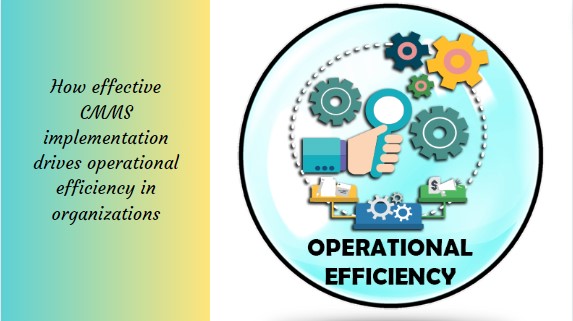
7 features of an effective CMMS software
Madhurima Sanyal |
26 Jun 2024 |
16:15 PM
- Unveiling the Attributes of a Highly Effective CMMS
- Understanding the Role of CMMS in Maintenance Management software
- What Makes a Highly Effective CMMS: Exploring Essential Functions
- The Core Features of Effective CMMS Software
- Key CMMS Software Features Explained for Seamless Integration
- Unveiling the Benefits of CMMS Solutions
- 7 Must-Have Maintenance Management Software Features
- 7 Essential Benefits for Effective Maintenance Operations
- Successful CMMS Implementation Strategies
- Conclusion

Smarter Decision-Making in Manufacturing: The Role of CMMS
Viki Dongare 03 Jun 2024 | 08:07 AMLearn how CMMS (Computerized Maintenance Management System) software is transforming maintenance management in manufacturing plants. Gain insights on how it is streamlining work order management, boosting efficiency, saving costs, and enhancing safety...
7 features of an effective CMMS software
Introduction to Effective CMMS Software
In maintenance management software, the 7 features of an effective CMMS software serve as pillars of operational efficiency, ensuring streamlined workflows and optimized asset performance. Let's learn about these essential attributes that define a high-performing CMMS and how it is helping modern-day maintenance managers.
Unveiling the Attributes of a Highly Effective CMMS
A robust CMMS software encompasses seven pivotal attributes, each contributing uniquely to operational success. From CMMS software's capacity to centralize data and tasks to its predictive prowess, understanding these attributes is fundamental for harnessing the software's full potential.
Understanding the Role of CMMS in Maintenance Management software
What role does CMMS play in the complex landscape of maintenance management software? It's not just a tool but a comprehensive solution that revolutionizes how organizations oversee maintenance tasks. It streamlines workflows, tracks assets, schedules preventive maintenance, and much more, significantly enhancing operational efficiency.
What Makes a Highly Effective CMMS: Exploring Essential Functions
Effective CMMS software isn't solely about features but about fulfilling core functions that empower businesses. Tracking maintenance tasks, managing inventory, and facilitating preventive maintenance are pivotal functions that ensure operational continuity for maintenance teams. Each function works in harmony, contributing to the software's overall efficacy.
As with any tool, understanding the fundamental functions of "CMMS software" is crucial to its successful implementation and utilization. By grasping these core functions, businesses can harness the full potential of CMMS software and elevate their maintenance management practices.
Employing these seven attributes empowers businesses to revolutionize their maintenance strategies, enhance asset longevity, and bolster overall operational efficiency.
The Core Features of Effective CMMS Software
Detailed Exploration of CMMS Attributes for Maximum ROI
An effective CMMS embodies seven critical attributes, each contributing significantly to the software's return on investment (ROI). From asset management and preventive maintenance scheduling to inventory management and work order management, each attribute plays a pivotal role in enhancing operational efficiency and maximizing ROI.
Interdependence of CMMS Functions: Understanding their Synergy
The synergy among different CMMS functions is integral to its effectiveness. A detailed examination of how these functions interdependently contribute to the overall efficiency of the system highlights the importance of their cohesive integration. The seamless integration capabilities and mobile accessibility, when combined with reporting and analytics, create a robust system that operates harmoniously to streamline maintenance processes.
Defining Clear CMMS Success Requirements for Optimal Results
Clarity in defining success requirements for a CMMS system is paramount. Understanding the specific needs of an organization, aligning maintenance processes, and ensuring clear CMMS success requirements facilitate optimal utilization of the software. This clarity ensures that the implemented CMMS aligns precisely with the organization's objectives, thereby yielding the desired outcomes.
By comprehensively exploring these core features, organizations can harness the full potential of CMMS software, streamline maintenance operations, and achieve enhanced efficiency and productivity.
Managing Assets and Staff Roles
In maintenance management software, effective management of assets and staff roles stands as a cornerstone for the seamless operation of a CMMS. Let's explore the critical aspects that define this fundamental domain:
Asset Health Management: Cornerstone of a Robust CMMS
Maintaining optimal asset health is pivotal in maximizing the efficiency of a CMMS. By leveraging predictive maintenance functionalities and continuous monitoring, organizations can proactively identify potential issues, extend equipment lifespans, and minimize unplanned downtime. This focus on asset management ensures a robust foundation for the CMMS to operate efficiently.
Role Definition within Management: Aligning Staff for Success
Clear and well-defined roles within management are essential for harnessing the full potential of a CMMS. When staff responsibilities are delineated effectively, tasks are streamlined, and accountability is established, fostering a collaborative environment conducive to achieving maintenance goals. Aligning staff roles optimizes workflow, ensuring efficient utilization of the CMMS.
Supporting Maintenance Processes: Mapping Efficiency and Effectiveness
Efficient maintenance processes are the backbone of a successful CMMS implementation. Mapping these processes within the system streamlines workflows, schedules tasks, and tracks progress effectively. It allows for the seamless execution of maintenance activities, fostering operational efficiency and ensuring the effectiveness of the CMMS.
Understanding and optimizing these crucial aspects—asset health management, role definition within management, and supporting maintenance managers —are pivotal for leveraging the full potential of a CMMS. When managed effectively, these elements contribute significantly to the success and efficiency of maintenance function.
Utilizing CMMS Functionalities
In maintenance management, leveraging the functionalities embedded within a CMMS (Computerized Maintenance Management System) is pivotal for streamlined operations and enhanced efficiency.
Creating Maintenance Management Dashboards for Enhanced Control
Maintenance management dashboards serve as command centers, offering real-time insights into operational performance. These visual representations amalgamate crucial data on work orders, asset health, and maintenance schedules, empowering stakeholders with a comprehensive view for informed decision-making and enhanced control.
Understanding Maintenance Management: From Concept to Execution
A deep comprehension of maintenance management—from its conceptual framework to its practical execution—is fundamental for harnessing the power of a CMMS. It involves not only the strategic planning of maintenance activities but also their systematic execution, ensuring optimized asset performance and operational continuity.
Key CMMS Software Features Explained for Seamless Integration
Each key CMMS software feature plays a pivotal role in ensuring the system's seamless integration and functionality. From preventive maintenance scheduling to inventory management and reporting capabilities, understanding these features is essential for maximizing the CMMS's effectiveness and achieving operational excellence.
Effectively harnessing these functionalities within a CMMS empowers organizations to optimize maintenance strategies, reduce downtime, and elevate operational efficiency to unprecedented levels.
Unveiling the Benefits of CMMS Solutions
The implementation of a robust CMMS (Computerized Maintenance Management System) can significantly revolutionize operations. Here, we'll delve into the advantages and benefits of adopting CMMS solutions, highlighting their pivotal role in enhancing efficiency and productivity within maintenance management.
7 Must-Have Maintenance Management Software Features
Exploring the essential features of a CMMS unveils the backbone of its functionality. From preventive maintenance scheduling to inventory management and reporting capabilities, comprehending these features provides insights into how a CMMS streamlines operations and elevates maintenance efficiency.
Advantages of Maintenance Management Systems (CMMS)
Maintenance management systems offer multifaceted advantages. They streamline processes, reduce downtime, optimize resource allocation, and enhance equipment longevity. Unpacking these benefits elucidates the transformative impact a CMMS can have on operational efficacy and cost savings.
7 Essential Benefits for Effective Maintenance Operations
A robust CMMS system offers a multitude of benefits that contribute to effective maintenance operations. From enhancing asset health to reducing downtime, streamlining workflows, and ensuring compliance, these advantages collectively optimize maintenance processes, foster operational efficiency, and drive cost-effective practices within an organization.
Understanding the benefits of an effective CMMS directly correlates to optimizing maintenance operations.
Improved Asset Management: CMMS enables proactive maintenance, extending equipment lifespan and ensuring optimal performance. Regular inspections, timely repairs, and predictive maintenance techniques ensure assets operate optimally, extending their lifespan and reducing the frequency of breakdowns.
Reduced Downtime: Timely maintenance scheduling minimizes unplanned equipment downtime, optimizing productivity. By employing preventive maintenance strategies facilitated by a CMMS, organizations can schedule maintenance activities during planned downtimes, minimizing the impact on daily operations.
Streamlined Workflows: Efficient task allocation and tracking within CMMS lead to smoother operations and task completion. This results in smoother task allocation, efficient completion of maintenance jobs, and reduced paperwork.
Proactive Issue Identification: Early detection of equipment issues prevents major breakdowns, saving time and resources. Through data analysis and condition monitoring, organizations can address issues at an early stage, preventing costly breakdowns and avoiding disruptions to operations.
Compliance Adherence: Following maintenance protocols helps meet regulatory standards, ensuring legal compliance and avoiding penalties. It facilitates the creation and enforcement of standardized maintenance procedures, ensuring that assets are regularly inspected, serviced, and maintained according to specified guidelines.
Increased Productivity: Well-maintained equipment operates efficiently, leading to higher productivity levels within operations. CMMS helps in ensuring that assets are in optimal working condition, thereby enabling employees to perform their tasks more effectively without interruptions due to equipment failures.
Cost Savings: Preventive maintenance reduces repair costs associated with unexpected breakdowns and enhances operational efficiency, resulting in financial savings. It minimizes the need for costly emergency repairs, extends the lifespan of assets, and optimizes the utilization of resources, resulting in significant cost savings for the organization.
Implementation of a robust CMMS system revolutionizes maintenance practices, ensuring proactive asset management and streamlined workflows. Leveraging predictive maintenance and enhancing asset health, CMMS drives efficiency, reduces downtime, and fosters cost-effective, productive operations.
Successful CMMS Implementation Strategies
This subsection offers a comprehensive guide derived from NEXGEN's expertise, outlining crucial steps and considerations necessary for a successful CMMS implementation. It highlights proven insights and best practices to ensure a smooth and effective transition.
Strategies and Best Practices for Efficient CMMS Integration
Discover effective strategies and best practices that facilitate seamless integration of CMMS into existing workflows. This section explores how to align the software with operational needs, optimize functionality, and foster a culture that maximizes the benefits of CMMS integration.
Conclusion
Throughout this exploration, we've unveiled the pivotal attributes and functions that define an effective CMMS, shedding light on its profound role in revolutionizing maintenance practices.
These seven features, encompassing centralized data management, predictive capabilities, and streamlined maintenance functions, signify the transformative power embedded within a robust CMMS. Understanding the essence of a CMMS goes beyond its functionalities; it represents a paradigm shift in maintenance management strategies, promising not just improved operational efficiency but also a substantial elevation in asset performance and longevity.
A profound comprehension of CMMS's role within maintenance management elucidates its multifaceted significance—more than just a tool, it's a comprehensive solution, reshaping how organizations oversee and execute maintenance tasks. The software amalgamates preventive maintenance, asset tracking, inventory management, and more, fundamentally altering how businesses optimize their operational workflows.
By embracing and employing these seven attributes, businesses can galvanize their maintenance strategies, elevate asset longevity, and fortify overall operational efficiency. These functions not only offer a roadmap to streamline maintenance operations but also promise a substantial return on investment, paving the way for sustainable growth and profitability.
Furthermore, managing assets and defining staff roles within the CMMS framework emerges as a cornerstone for seamless operations. The effective management of asset health through predictive maintenance and the alignment of staff roles foster an environment conducive to achieving maintenance goals efficiently. This integration and understanding are essential for achieving optimal utilization and outcomes from the CMMS implementation.
Moreover, leveraging CMMS functionalities and implementing it effectively stand as pivotal steps for streamlined operations and enhanced productivity. From creating maintenance management dashboards to understanding maintenance processes and seamless integration, every aspect contributes to unlocking the CMMS's full potential.